Diagnosis and Monitoring of Tunnel Lining Defects by Using Comprehensive Geophysical Prospecting and Fiber Bragg Grating Strain Sensor
Abstract
:1. Introduction
2. Tunnel Defects and Comprehensive Prospecting Diagnosis
3. Force Analysis of CFRP Strengthening Tunnel Lining
4. Analysis of Monitoring Results of Tunnel Lining Strain
5. Discussion and Conclusions
Author Contributions
Funding
Data Availability Statement
Conflicts of Interest
References
- Tyagi, A.; Lee, F.H. Influence of tunnel failure on the existing large-diameter tunnel in improved soil surround. Tunn. Undergr. Space Technol. 2022, 120, 10426. [Google Scholar] [CrossRef]
- Sun, H.; Chen, Y.; Zhang, J.; Kuang, T. Analytical investigation of tunnel deformation caused by circular foundation pit excavation. Comput. Geotech. 2019, 106, 193–198. [Google Scholar] [CrossRef]
- Wang, J.; Cao, A.; Wu, Z.; Sun, Z.; Lin, X.; Sun, L.; Liu, X.; Li, H.; Sun, Y. Numerical Simulation on the Response of Adjacent Underground Pipelines to Super Shallow Buried Large Span Double-Arch Tunnel Excavation. Appl. Sci. 2022, 12, 621. [Google Scholar] [CrossRef]
- Fan, S.; Song, Z.; Xu, T.; Wang, K.; Zhang, Y. Tunnel deformation and stress response under the bilateral foundation pit construction: A case study. Arch. Civ. Mech. Eng. 2021, 21, 109. [Google Scholar] [CrossRef]
- Nie, L.; Ma, C.; Xu, T.; Wang, C.; Wan, C.; Liu, R.; Liu, Z.; Liu, Z.; Zhou, W.; Li, J.; et al. Tunnel deformation and stress response under the bilateral foundation pit construction: A case study. J. Environ. Eng. Geophys. 2019, 24, 537–547. [Google Scholar] [CrossRef]
- Huang, X.; Xu, Z.; Lin, P.; Liu, B.; Nie, L.; Liu, T.; Su, M. Identification Method of Water and Mud Inrush Hazard-Causing Structures in Tunnel and its Application. J. Basic Sci. Eng. 2020, 28, 103–122. [Google Scholar]
- Shao, X.; Lin, Z.; Song, J. Causes of Tunnel Diseases in a Karst Stratum and Remediation Measures: A Case Study. Front. Earth Sci. 2022, 10, 3389. [Google Scholar]
- Li, Y.; Wang, H.; Cai, W.; Li, S.; Zhang, Q. Stability monitoring of surrounding rock mass on a forked tunnel using both strain gauges and FBG sensors. Measurement 2020, 153, 107449. [Google Scholar] [CrossRef]
- Song, H.; Pei, H.; Zhu, H. Monitoring of tunnel excavation based on the fiber Bragg grating sensing technology. Measurement 2021, 169, 108334. [Google Scholar] [CrossRef]
- Singh, M.J.; Choudhary, S.; Chen, W.; Wu, P.; Goyal, M.K.; Rajput, A.; Borana, L. Applications of fibre Bragg grating sensors for monitoring geotechnical structures: A comprehensive review. Measurement 2023, 218, 113171. [Google Scholar] [CrossRef]
- Wang, Q.; Zhao, K.; Badar, M.; Yi, X.; Lu, P.; Buric, M.; Mao, Z.; Chen, K. Improving OFDR Distributed Fiber Sensing by Fibers with Enhanced Rayleigh Backscattering and Image Processing. IEEE Sens. J. 2022, 22, 18471–18478. [Google Scholar] [CrossRef]
- Xu, J.; Tang, C.; Cheng, Q.; Vahedifard, F.; Liu, B.; Shi, B. Monitoring and early detection of soil desiccation cracking using distributed fibre optical sensing. Geotechnique 2022, 1–12. [Google Scholar] [CrossRef]
- Liu, H.; Zhang, S.; Coulibaly, A.; Cheng, J.; DeJong, M. Monitoring Reinforced Concrete Cracking Behavior under Uniaxial Tension Using Distributed Fiber-Optic Sensing Technology. J. Struct. Eng. 2021, 147, 04021212. [Google Scholar] [CrossRef]
- Lai, J.; Qiu, J.; Fan, H.; Zhang, Q.; Hu, Z.; Wang, J.; Chen, J. Fiber Bragg Grating Sensors-Based In Situ Monitoring and Safety Assessment of Loess Tunnel. J. Sens. 2016, 2016, 8658290. [Google Scholar] [CrossRef]
- Ding, L.; Sun, Y.; Zhang, W.; Bi, G.; Xu, H. Stress Monitoring of Segment Structure during the Construction of the Small-Diameter Shield Tunnel. Sensors 2023, 23, 8023. [Google Scholar] [CrossRef]
- Mu, B.; Xie, X.; Li, X.; Li, J.; Shao, C.; Zhao, J. Monitoring, modelling and prediction of segmental lining deformation and ground settlement of an EPB tunnel in different soils. Tunn. Undergr. Space Technol. 2021, 113, 103870. [Google Scholar] [CrossRef]
- Li, C.; Zhao, Y.; Liu, H.; Wan, Z.; Xu, J.; Xu, X.; Chen, Y. Strain and Back Cavity of Tunnel Engineering Surveyed by FBG Strain Sensors and Geological Radar. J. Intell. Mater. Syst. Struct. 2009, 20, 2285–2289. [Google Scholar] [CrossRef]
- Li, C.; Zhao, Y.; Liu, H.; Zhang, Z.; Wan, Z.; Chen, Y.; Xu, X.; Xu, J. Combined interrogation using an encapsulated FBG sensor and a distributed Brillouin tight buffered fiber sensor in a Tunnel. Struct. Health Monit. 2010, 9, 341–346. [Google Scholar]
- Lv, Q.; Bu, S.; Wang, S.; Jia, M. Application of comprehensive geophysical prospecting method in stability evaluation of landslide. Chin. J. Geotech. Eng. 2015, 37, 142–147. [Google Scholar]
- Liu, S.; Pan, J.; Wang, H.; Qi, Q.; Tang, Z. Feng, M.; Lou, J.; Zhang, Y. Assessment of rock burst risk in roadway based on the combination of seismic and electromagnetic wave CT technology. J. Chin. Chem. Soc. 2018, 43, 2980–2991. [Google Scholar]
- Xue, F.; Cai, M.; Wang, T.; Zhao, T. Characteristics of Karst Cave Development in Urban Karst Area and Its Effect on the Stability of Subway Tunnel Construction. Adv. Civ. Eng. 2021, 2021, 8894713. [Google Scholar] [CrossRef]
- Li, J.; Gao, J.; Wang, Y. Supersonic wave testing on concrete crack depth and analysis of crack initiation. Rock Soil Mech. 2001, 22, 291–293. [Google Scholar]
- Fu, Z.; Wang, X. Study of ultrasonic nondestructive testing detecting the defects of concrete components. Appl. Mech. Mater. 2007, 28, 783–788. [Google Scholar]
- Arash, T.; Ahmadreza, A.; Sina, S. Effect of Different Arrangements of CFRP Wraps on the Axial Stress–Strain Behaviour of Confined Concrete Cylinders: Experimental Study and Numerical Modelling. Iran. J. Sci. Technol.-Trans. Civ. Eng. 2020, 44, 1087–1100. [Google Scholar]
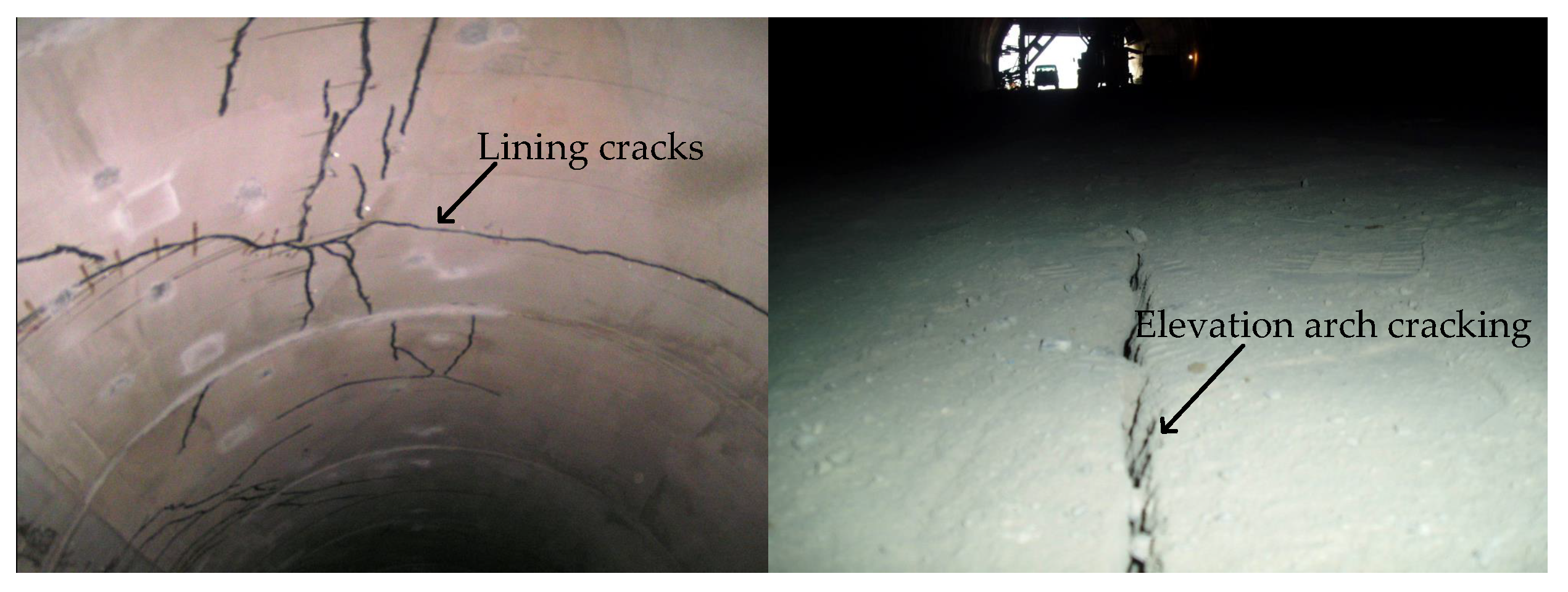

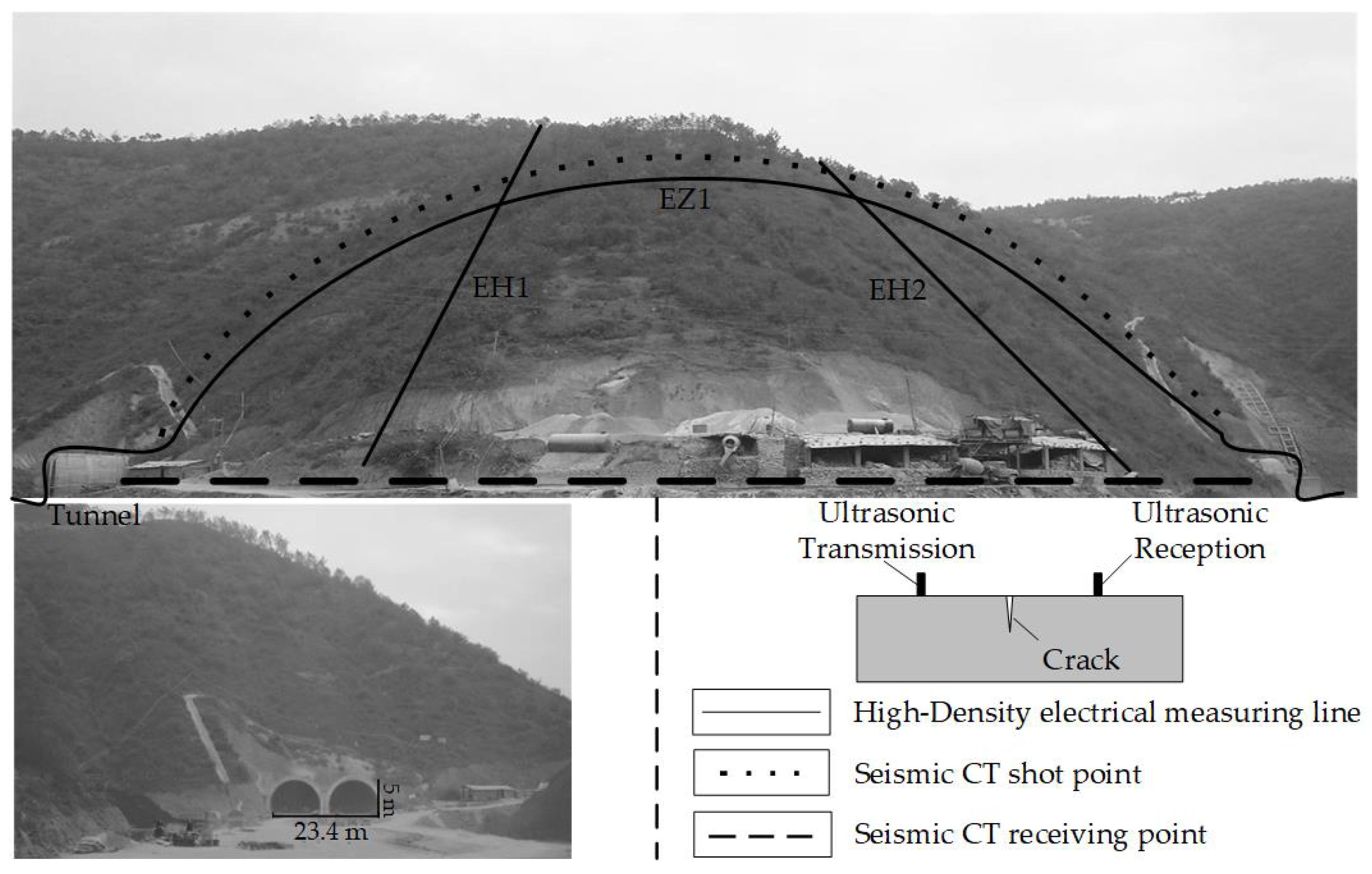
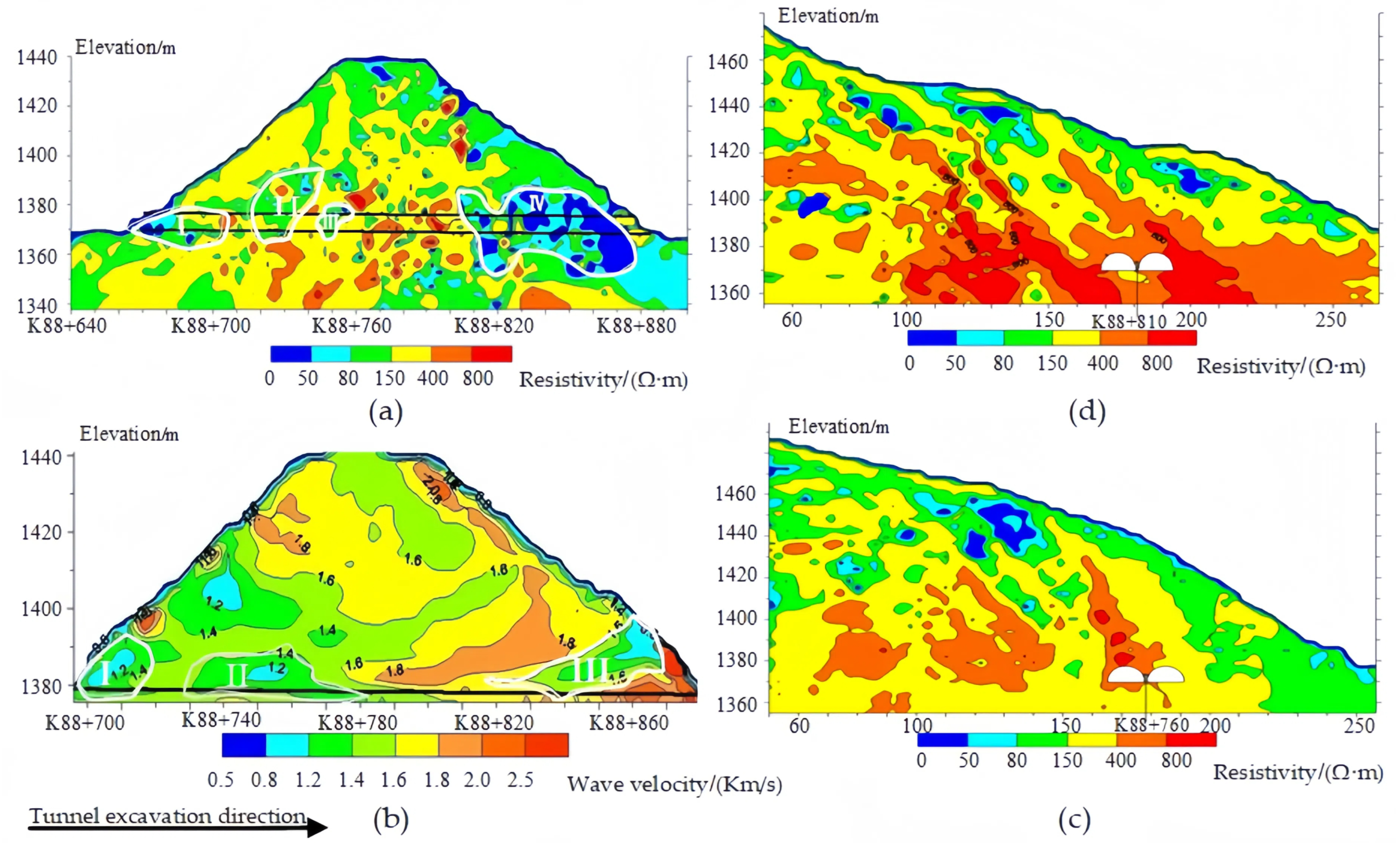
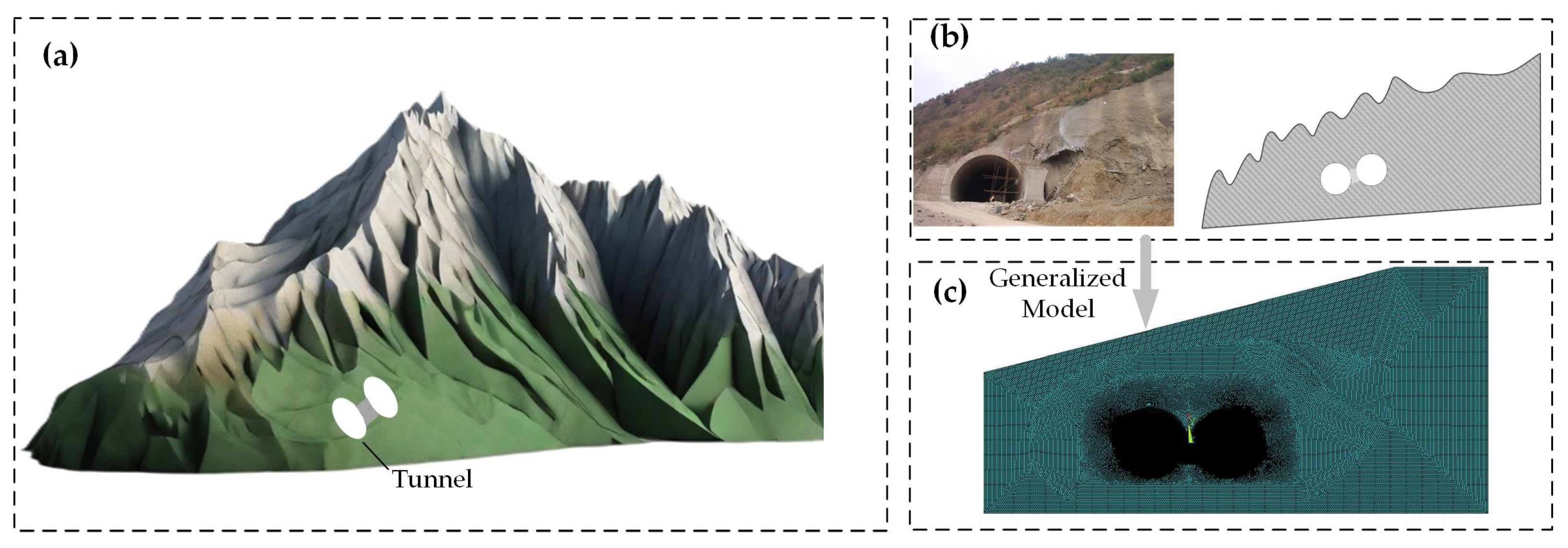
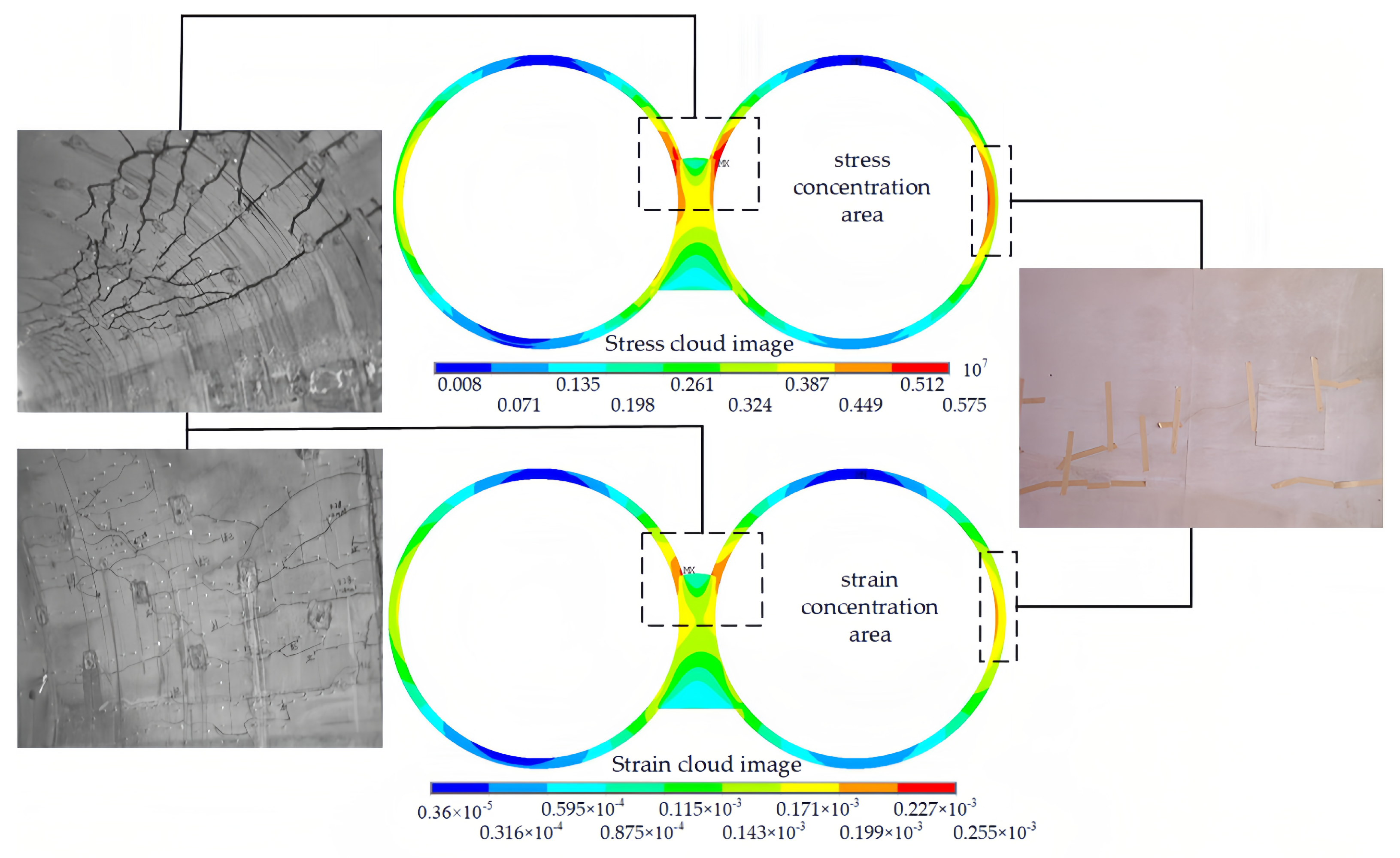
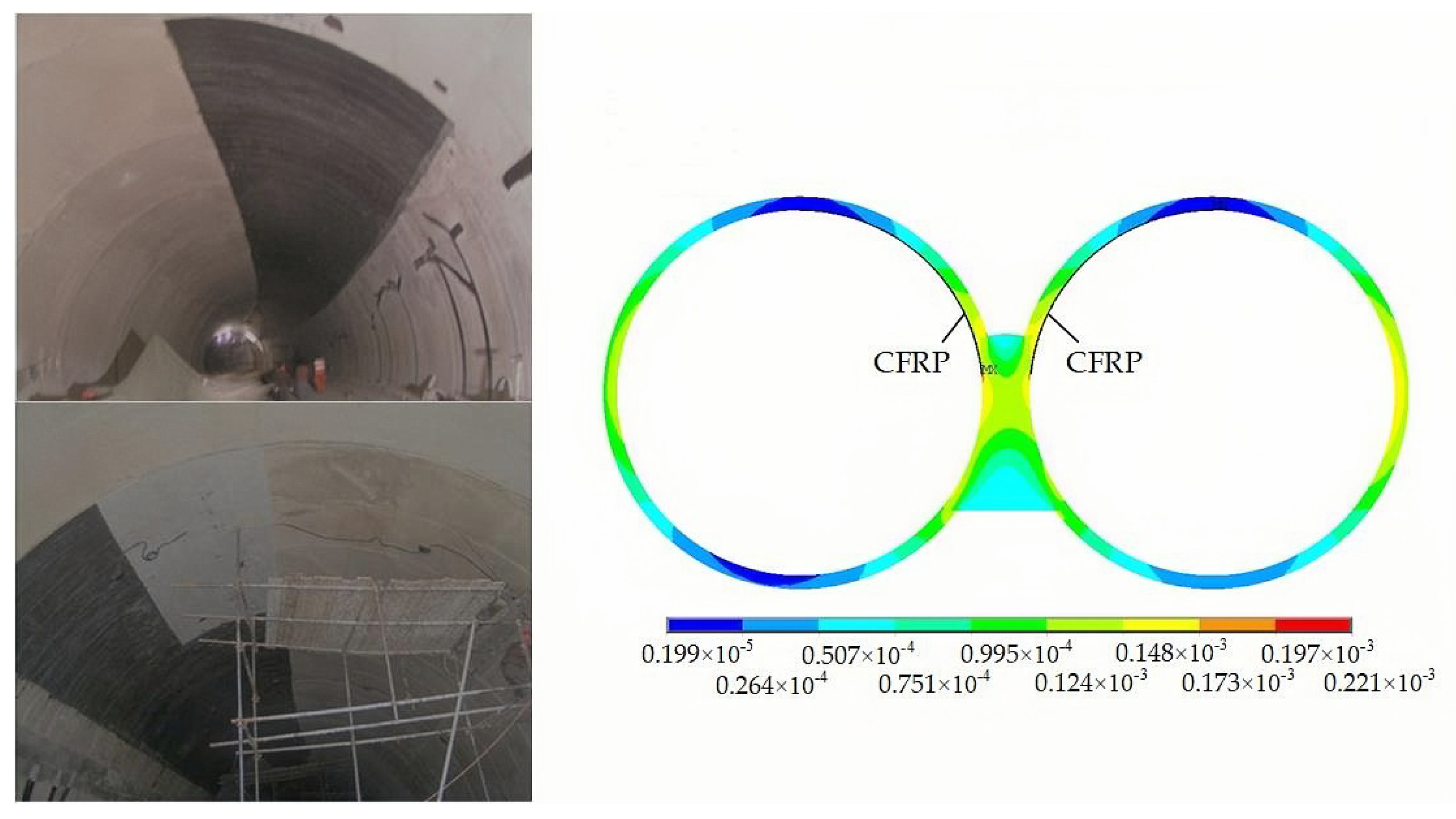

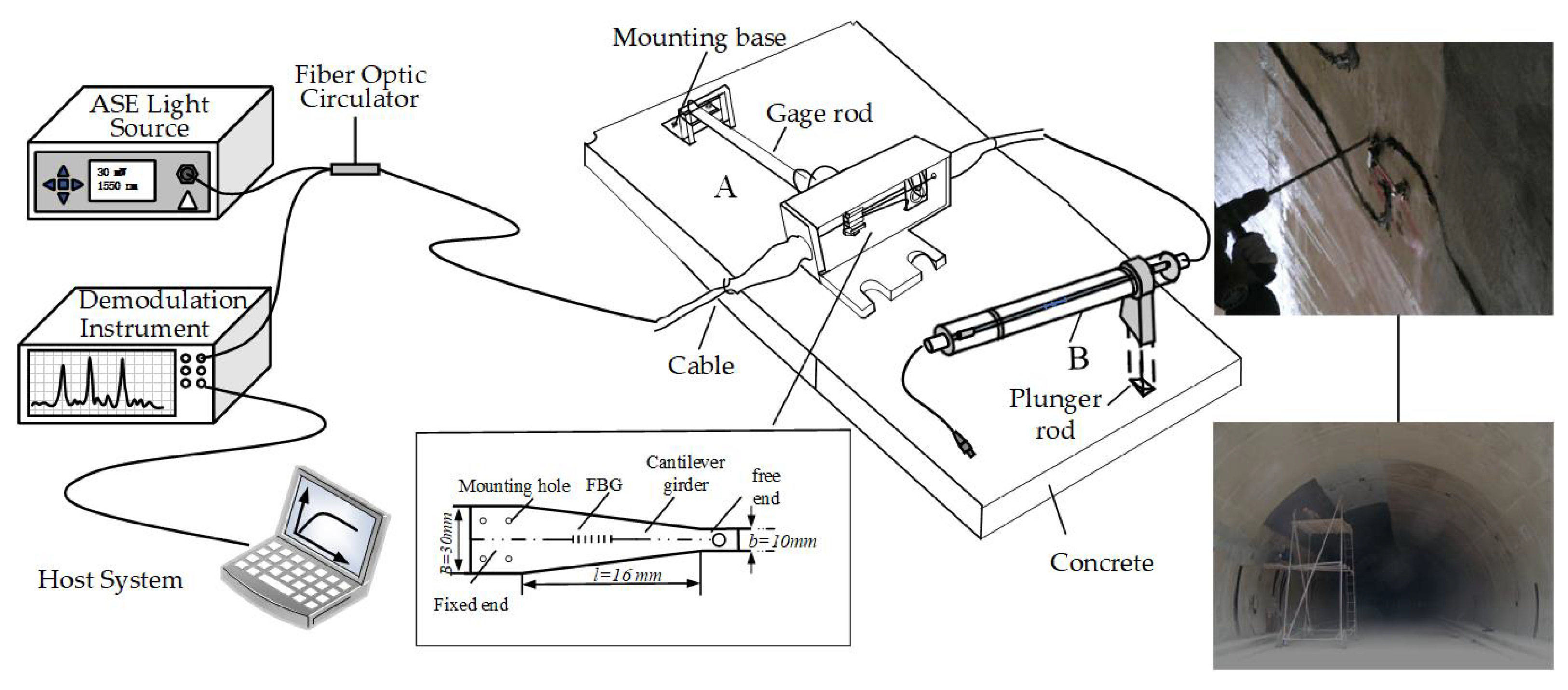

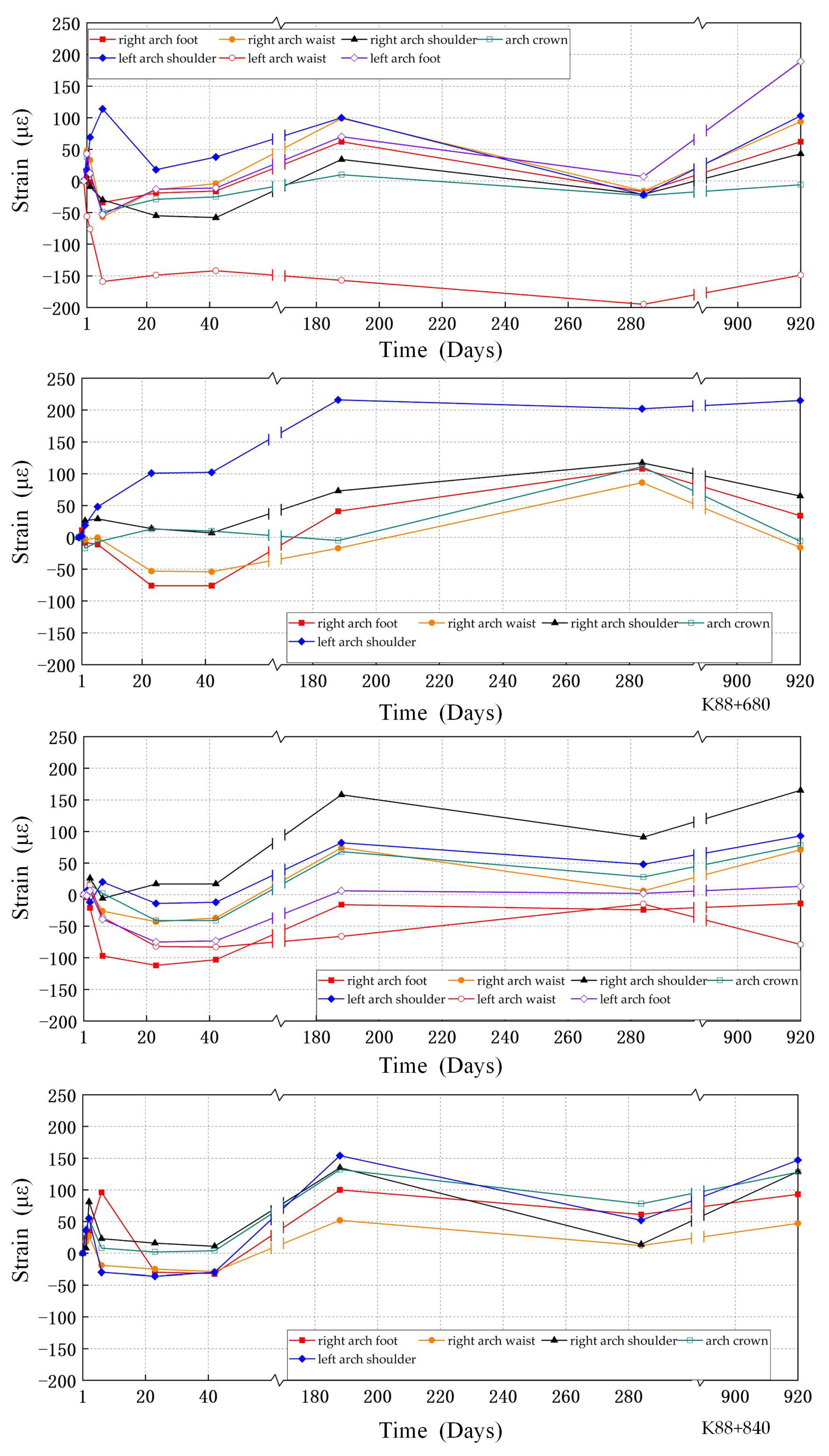
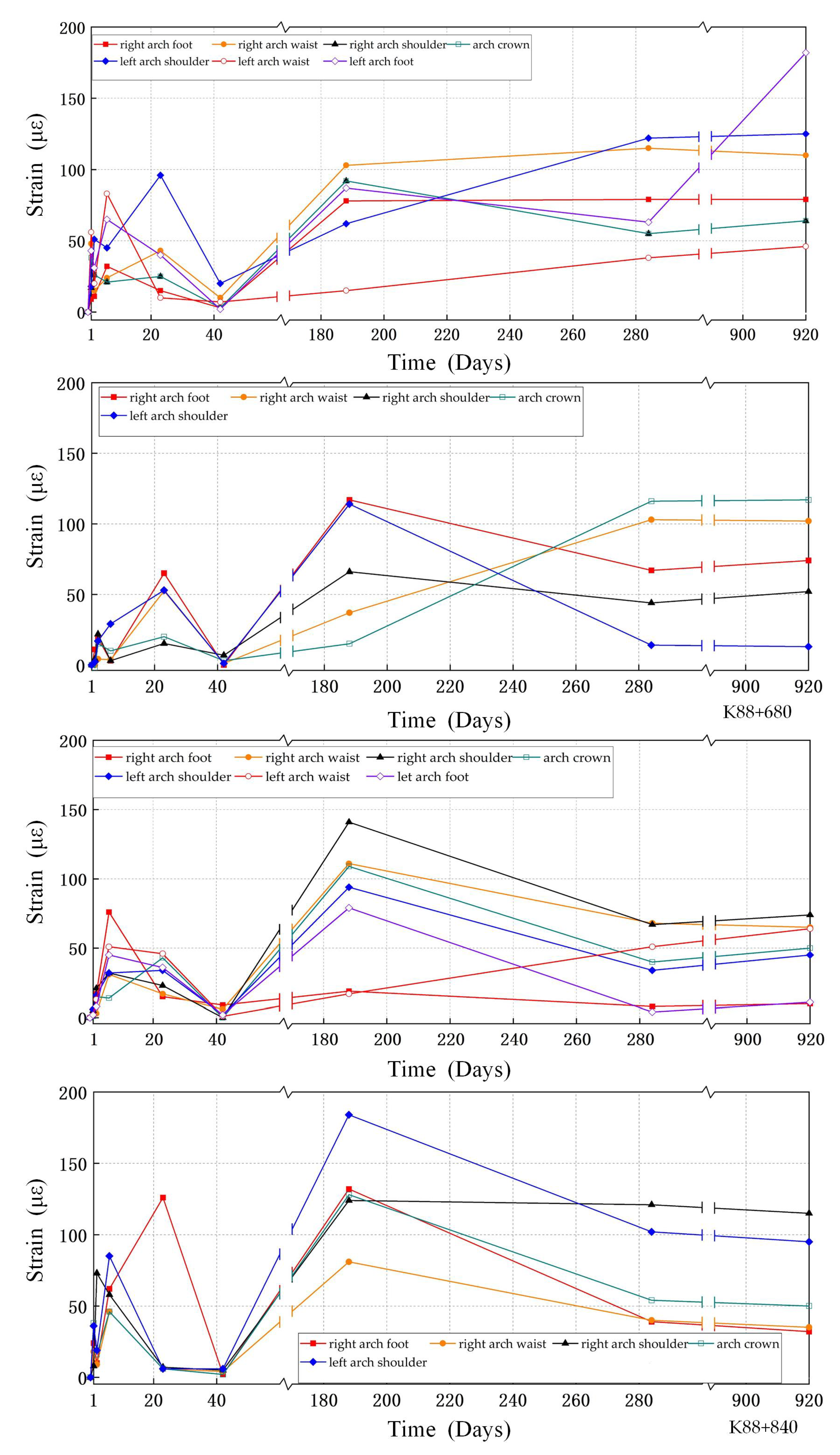
| Position | Width (mm) | Depth (mm) | Position | Width (mm) | Depth (mm) |
|---|---|---|---|---|---|
| K88+682 | 1.00 | 297 | K88+735 | 0.84 | 252 |
| K88+696 | 0.60 | 188 | K88+742 | 1.40 | 459 |
| K88+705 | 0.60 | 289 | K88+751 | 1.00 | 450 |
| K88+708 | 1.20 0.70 | 331 365 | K88+754 | 1.00 | 335 |
| K88+714 | 0.80 1.00 | 163 127 | K88+764 | 1.00 | 401 |
| K88+718 | 1.04 | 326 | K88+775 | 1.00 | 354 |
| K88+723 | 1.44 | 423 | K88+781 | 0.88 | 290 |
| K88+728 | 1.60 1.60 1.20 | 360 437 114 | K88+817 | 1.00 | 328 |
| K88+824 | 0.80 | 214 | K88+811 | 1.00 | 311 |
| K88+833 | 1.00 | 195 | K88+833 | 1.00 | 232 |
| Material Name | Elastic Modulus | Density | Poisson’s Ratio | Fiction Angle |
|---|---|---|---|---|
| (E/GPa) | (Kg/m3) | (Θ/°) | ||
| IV Grade surrounding rock | 4.95 | 2.20 × 103 | 0.32 | 37 |
| Tunnel lining | 30 | 2.36 × 103 | 0.20 | 54 |
| CFRP | 235 | 1.75 × 103 | 0.26 | - |
Disclaimer/Publisher’s Note: The statements, opinions and data contained in all publications are solely those of the individual author(s) and contributor(s) and not of MDPI and/or the editor(s). MDPI and/or the editor(s) disclaim responsibility for any injury to people or property resulting from any ideas, methods, instructions or products referred to in the content. |
© 2024 by the authors. Licensee MDPI, Basel, Switzerland. This article is an open access article distributed under the terms and conditions of the Creative Commons Attribution (CC BY) license (https://creativecommons.org/licenses/by/4.0/).
Share and Cite
Li, C.; Li, J.; Luo, C.; Xu, Q.; Wan, X.; Yang, L. Diagnosis and Monitoring of Tunnel Lining Defects by Using Comprehensive Geophysical Prospecting and Fiber Bragg Grating Strain Sensor. Sensors 2024, 24, 1749. https://doi.org/10.3390/s24061749
Li C, Li J, Luo C, Xu Q, Wan X, Yang L. Diagnosis and Monitoring of Tunnel Lining Defects by Using Comprehensive Geophysical Prospecting and Fiber Bragg Grating Strain Sensor. Sensors. 2024; 24(6):1749. https://doi.org/10.3390/s24061749
Chicago/Turabian StyleLi, Chuan, Jiaqi Li, Chuan Luo, Qiang Xu, Xiaorong Wan, and Lubing Yang. 2024. "Diagnosis and Monitoring of Tunnel Lining Defects by Using Comprehensive Geophysical Prospecting and Fiber Bragg Grating Strain Sensor" Sensors 24, no. 6: 1749. https://doi.org/10.3390/s24061749






